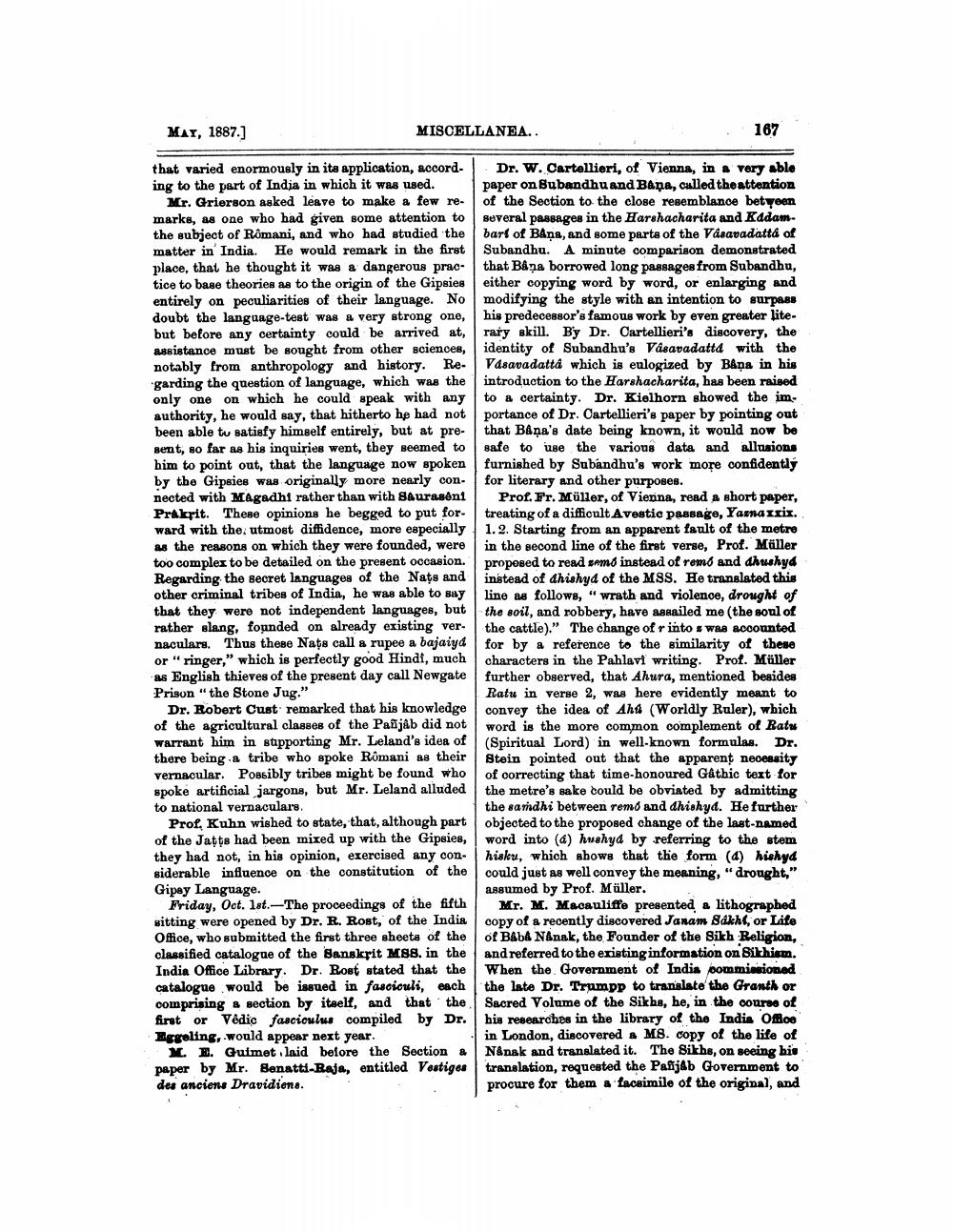________________
MAY, 1887.]
MISCELLANEA..
-
167
that varied enormously in its application, according to the part of India in which it was used.
Mr. Grierson asked leave to make a few remarks, as one who had given some attention to the subject of Romani, and who had studied the matter in India. He would remark in the first place, that he thought it was a dangerous practice to base theories as to the origin of the Gipsies entirely on peculiarities of their language. No doubt the language-test was a very strong one, but before any certainty could be arrived at, assistance must be sought from other sciences, notably from anthropology and history. Re. 'garding the question of language, which was the only one on which he could speak with any authority, he would say, that hitherto he had not been able tu satisfy himself entirely, but at present, so far as his inquiries went, they seemed to him to point out, that the language now spoken by the Gipsies was originally more nearly con- nected with Magadhi rather than with Sauraseni Prakrit. These opinions he begged to put for ward with the utmost diffidence, more especially as the reasons on which they were founded, were too complex to be detailed on the present occasion. Regarding the secret languages of the Nats and other criminal tribes of India, he was able to say that they were not independent languages, but rather slang, founded on already existing ver- naculars. Thus these Nats call a rupee a bajaiyd or "ringer," which is perfectly good Hindt, much as English thieves of the present day call Newgate Prison "the Stone Jug."
Dr. Robert Cust: remarked that his knowledge of the agricultural classes of the Paõjab did not warrant him in stupporting Mr. Leland's idea of there being a tribe who spoke Rômani as their vernacular. Possibly tribes might be found who spoke artificial jargons, but Mr. Leland alluded to national vernaculars.
Prof. Kuhn wished to state, that, although part of the Jatts had been mixed up with the Gipsies, they had not, in his opinion, exercised any con
iderable influence on the constitution of the Gipsy Language.
Friday, Oct. 1st.-The proceedings of the fifth sitting were opened by Dr. R. Rost, of the India Office, who submitted the first three sheets of the classified catalogue of the Sanskrit M88. in the India Office Library. Dr. Rost stated that the catalogue would be issued in fasciculi, each comprising a section by itsell, and that the first or Védic fasciculus compiled by Dr. Egeling, would appear next year.
X. E. Guimet laid before the Section & paper by Mr. Benatti-Raja, entitled Vestiges des anciens Dravidiens.
Dr. W. Cartellieri, of Vienna, in a very ablo paper on Bubandhu and Bapa, called theattention of the Section to the close resemblance between Beveral passages in the Harshacharita and Kadam. bart of Bana, and some parts of the Vasavadatta of Subandhu. A minute comparison demonstrated that Båna borrowed long passages from Subandha, either copying word by word, or enlarging and modifying the style with an intention to surpass his predecessor's famous work by even greater lite. rary skill. By Dr. Cartellieri's discovery, the identity of Subandhu's Vasaradatta with the Vasavadatta which is eulogized by B&ņa in his introduction to the Harshacharita, has been raised to a certainty. Dr. Kielhorn showed the im. portance of Dr. Cartellieri's paper by pointing out that Bana's date being known, it would now be safe to use the various data and allusions furnished by Subandhu's work more confidently for literary and other purposes.
Prof. Fr. Müller, of Vienna, read a short paper, treating of a difficult Avestic passage, Yasna xxix. 1.2. Starting from an apparent fault of the metre in the second line of the first verse, Prof. Möller proposed to read somo instead of remo and thushyd instead of thishyd of the MSS. He translated this line as follows, "wrath and violence, drought of the soil, and robbery, have assailed me (the soul of the cattle)." The change of r into s was accounted for by a reference to the similarity of these characters in the Pahlavi writing. Prof. Müller further observed, that Ahura, mentioned besides Ratu in verse 2, was here evidently meant to convey the idea of Ahd (Worldly Ruler), which word is the more common complement of Ratu (Spiritual Lord) in well-known formulas. Dr. Stein pointed out that the apparent necessity of correcting that time-honoured Gathic text for the metre's sake could be obviated by admitting the sandhi between remo and thishyd. He further objected to the proposed change of the last-named word into (a) hushyd by referring to the stem hisku, which shows that the form (a) hishyd could just as well convey the meaning, "drought," assumed by Prof. Müller.
Mr. M. Macauliffe presented a lithographed copy of a recently discovered Janam Sakht, or Life of Bb Nának, the Founder of the Sikh Religion, and referred to the eristing information on Sikhism. When the Government of India commissioned the late Dr. Trumpp to translate the Granth or Sacred Volume of the Sikhs, he, in the course of his researches in the library of the India Office in London, discovered a MS. copy of the life of N&nak and translated it. The Sikhs, on seeing his translation, requested the Pafijab Government to procure for them a facsimile of the original, and




